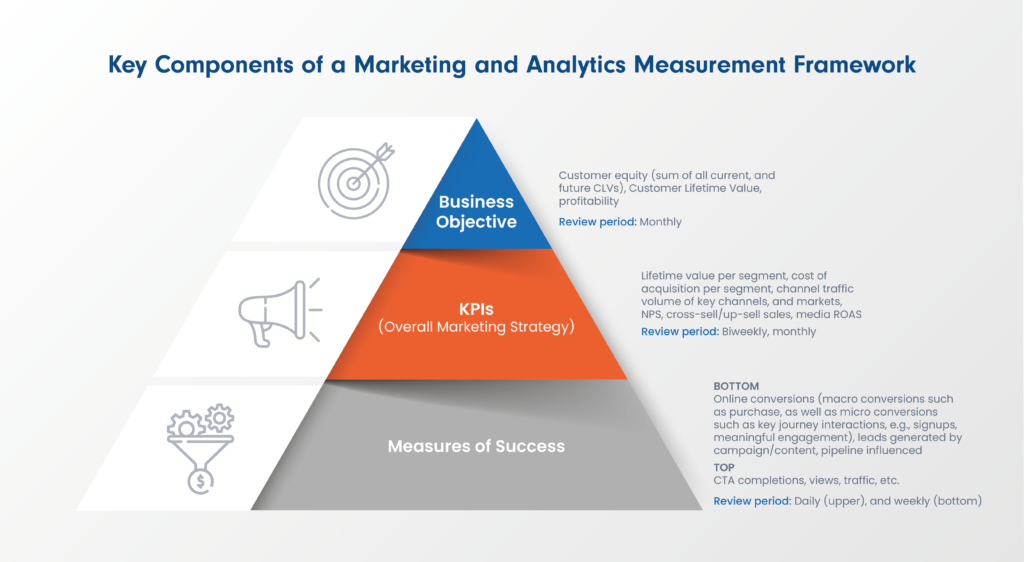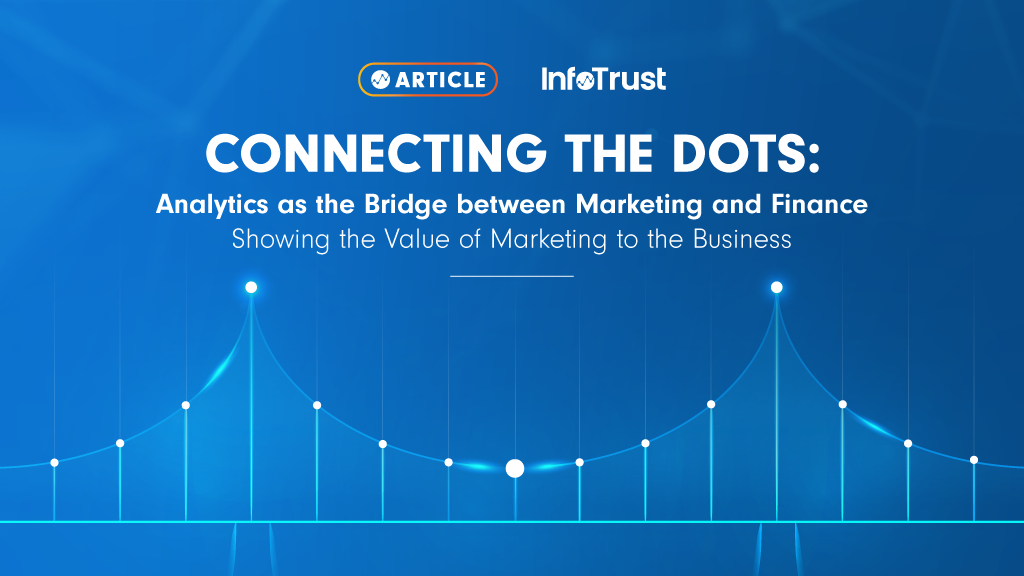TL;DR
- A marketing and analytics measurement plan is a key—and often overlooked—framework that marketers use to connect the value of marketing activities to business value.
- Executives have a key role: Your input is fundamental in aligning toward the strategic business objective. Meaningful contribution will result in greater clarity and help avoid costly investments with low return.
- Analytics provides structured thinking that visibly connects marketing and measurement goals to business goals, aligns teams on larger objectives, and clarifies purpose.
- Analytics forces an organization to focus on meaningful metrics, and how they ladder up to marketing strategy KPIs: Provides for data minimization, and helps develop clarity in approach by focusing the contributions of tactical marketing activities to strategy and measuring it.
- Analytics provides an understanding of how upper-funnel activities can be used as indicators of lower-funnel success, and ultimately strategy and business objectives.
“Budget is tight right now, so we’re not going to be able to approve your marketing plan unless you’re able to give us an idea of how this is going to impact our bottom line.”
I can imagine that you’ve heard this line before, likely multiple times. While countless marketers have been here, it’s even more relevant in today’s economic conditions.
Without an answer, how are you going to secure more, or ongoing budget? How are you going to demonstrate the business value of your marketing efforts?
One of the main purposes of marketing analytics is precisely this—to provide metrics that are not only marketing-specific and indicate progress toward or achievement of a marketing goal, but metrics that, when taken in aggregate, show an impact on the business objectives. It is specifically at this point where the role of executives, particularly marketing, analytics and finance, is paramount—and frequently missing.
A marketing and analytics measurement framework is an excellent model that marketers may use in aligning their investments in marketing and analytics with business objectives. Why should executives use them, and how can you go about ensuring that the first, foundational steps are covered?

The framework provides structured thinking that visibly connects marketing and measurement goals to business goals, it forces teams to identify relevant business objectives and agree up-front on what success looks like, and it helps to establish a fundamental aspect of marketing and analytics: the purpose. As InfoTrust’s Chief Growth Officer Michael Loban explains in his Forbes article on The 6 Ps Of Digital Analytics Transformation, “purpose explains to everyone what you’re looking to accomplish and why it matters. Without having a clearly stated purpose, digital transformation simply cannot happen.”
Analytics is not a magic bullet; it does not make an organization inherently “data-driven”—it is a competitive business tool provided it is properly planned, deployed, and used. We have seen countless examples of large digital analytics investments flounder as a result of an unclear vision and purpose.
For this reason, executives play a key role at this initial stage. Your meaningful input is fundamental in aligning toward the strategic business objectives, and without your clear direction on what objectives the team should pursue and measure, your analytics program may easily start off on the wrong course—spending hundreds of thousands of dollars in vain on platform costs, vendors, and employee hours. Start with strong foundations: develop KPIs that measure the success of your digital initiatives and combine with measures of financial and business success.
While this first part may sound easy, it is far from it—and most important to get right. It requires deep collaboration, and as CMOs and CFOs work together to develop a data vision reflected by analytics, the departments should align on what constitutes a worthwhile financial and marketing target. Some key financial indicators that marketers should consider include: Customer Lifetime Value, profitability, cost per customer, ROI, cross-sell/up-sell sales (or sales impacted), among others. The point here is that these are top-down KPIs that are impacted by lower-level leading indicators, all of which are tracked and reported by analytics.
Non-financial but nonetheless important marketing strategy indicators may include cost of acquisition per segment and lifetime value per segment. For long-term measures, marketers can look to brand health indicators. (Although much more difficult to measure, do not underestimate the importance of brand—according to Interbrand’s 2022 Best Global Brands report, Apple’s brand alone is worth $482.2 B.)
As the marketing and analytics framework is developed further down, it forces an organization to focus on meaningful measurement metrics and plan for their collection, while forgoing extraneous data. This helps in data minimization (an important compliance point in our increasingly privacy-centric world). Similarly, it provides an understanding of how upper-funnel efforts can be used as indicators of lower-funnel success, and ultimately sales (as noted above). What this means in practice is that, as executives cross-departmentally clarify what success looks like and quantify it in the form of KPIs, more marketing and analytics teams must then weigh in and consider what are the best indicators to track. Focus on tracking those, and limit your tracking of extraneous data that does not add value. Do not drown in data, be lean, and focus on driving the actions that matter most.
As we know, perfect measurement—especially in certain marketing activities—is an elusive ideal; however, marketers should not focus on perfection, but rather, on incremental progress. To that end, developing a marketing and analytics measurement model, with all of the key collaborative input that it requires, is a key first step.
Below are some suggestions of key components that you may want to consider while building out such a framework. Note that this same framework can be used across acquisition, engagement, conversion, and retention, as well as across a variety of segments (existing/new customers, commercial/non-commercial, etc.).
Key components of a marketing and analytics measurement framework, mapping back to business objectives
Business objective: What are the CEO, CFO, and CMO looking to achieve and show as metrics of success? Collaborate on defining a clear vision to track.
- Examples: Customer equity (sum of all current and future CLVs), Customer Lifetime Value, profitability
- Review period: Monthly
KPIs (overall marketing strategy): These must impact the business objective above.
- Examples: Lifetime value per segment, cost of acquisition per segment, channel traffic volume of key channels and markets, NPS, cross-sell/up-sell sales, media ROAS
- Review period: Biweekly, monthly
Measures of success: These are more tactical metrics which serve as leading indicators of the above; they are at granular, campaign levels. These can be both for bottom- and top-of-funnel activities.
- Examples (bottom): Online conversions (macro conversions such as purchase, as well as micro conversions such as key journey interactions, e.g., signups, meaningful engagement), leads generated by campaign/content, pipeline influenced
- Examples (top): CTA completions, views, traffic, etc.
- Review period: Daily (upper) and weekly (bottom)


